Well what a weekend – we had had two really intense full on challenging battles, one rather frustrating indecisive game, and one very decisive win. As with previous BattleCry events games were generally played in good spirits and the environment was great. The new venue at the ASB Basketball Stadium was fantastic and I look forward to future events being there… Once again Philip and Andrew had the ‘most ancient’ army present, and special thanks to Battleline Miniatures for the competition prizes.
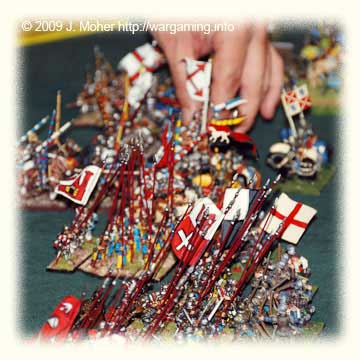
One interesting result of the competition was only one team achieved more than 1 win – that was Ivan & Dickie with the Portuguese who got 3 (albeit costly) wins out of 4 games, their fourth game being an advantageous draw. We were next best with the one 25-0 decisive win and 2 advantageous draws, followed by Philip & Andrew (Kushites) with one 25-0 decisive win and a losing draw.
The other three teams all had 1 very costly win each (17-8) with only Brett & Lawrence getting any draws (1 advantageous & 1 losing). In the end this is basically exactly the same numbers (and pretty much the same teams) as with last year – showing a fair consistency with both the players and the rules and Victory Points.
This as a result gives a good feel for the DBMM points system giving the right results in terms of the points versus how decisive a win is achieved; in the past with DBM it was possible to do well in tournaments using the VP system by not playing and aiming just for advantageous draws & marking time… With DBMM you need to be decisive on the table.
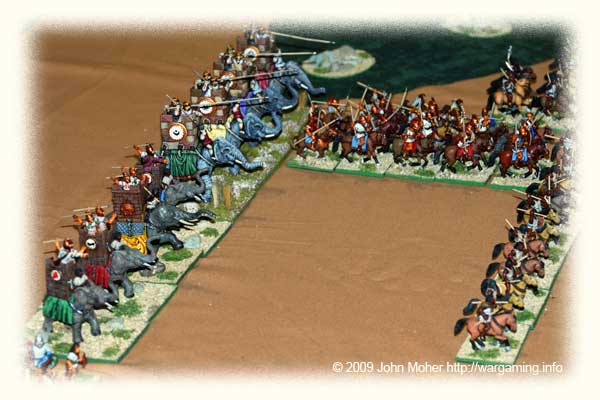
For some reason I found DBMM a bit of struggle this year – while I still think its a great rule set I just could not recall key details when I needed to, which I think just is symptomatic of the learning curve – I hadn’t played since last BattleCry and had crammed in 3 practice/reminder games in the 5 weeks prior but still hadn’t refreshed or absorbed enough! But overall it was an enjoyable weekend.
Final Tournament Rankings & Results
| Team | Army | Year | Points | OD | R1 | R2 | R3 | R4 | |
|---|---|---|---|---|---|---|---|---|---|
| 1 | Ivan Truong & Richard Foster | Medieval Portuguese with English Ally | 1385AD | 74 | 189 | 14 | 19 | 20 | 21 |
| 2 | John Moher & Campbell Millar | Kushans | 391AD | 60 | 189 | 25 | 6 | 15 | 14 |
| 3 | Brett Preston-Thomas & Lawrence Antill | Medieval Germans, with Swiss Allies | 1428AD | 51 | 189 | 11 | 17 | 8 | 15 |
| 4 | Philip Abela & Andrew Hunter | Kushite Egyptian | 727BC | 49 | 222 | 25 | 8 | 5 | 11 |
| 5 | Andrew Bennetts & Al Donald | Later Carthaginian, with Numidian Ally, & Brilliant C-in-C: Hannibal | 202BC | 37 | 189 | 0 | 17 | 10 | 10 |
| 6 | John Calnan & Lance Knighton | Sassanid Persians, with Sabir Hun Allies | 463AD | 29 | 222 | 0 | 8 | 17 | 4 |
Points: Total Score out of a possible 100 (i.e. 25 VP maximum for each of the 4 games).
Opponent Difficulty (OD): A Buchholz style challenge ranking based on the final competition scores of the 4 opponents each team played. The higher the score the tougher the opponents faced (in theory), ideal for breaking ties in final points if needed or seeing if someone got an ‘easy draw’ for opponents in larger competitions. Due to the small size of this competition and the fact everyone played everyone bar one you can see how the OD has effectively equalled out with just two mid to low placed teams having a higher OD as a result. Also gives an indication to some degree of opponent challenge.
Round Scores (R1, R2, R3, R4): The individual Victory Point Scores for each team’s game in each round. Scores of 10-15 are draws, everything above is a win, everything below a loss. The winning team achieved 3 wins; the other 5 teams had 1 win apiece – total for the entire competition was 8 Wins & 4 Draws from 12 Games. A couple of those 4 draws are possibly due to lost time and/or slow set-ups eating up playing time.*
I have found both Doubles Competitions with DBMM have resulted in very slow game starts – in our case this year not one of our games started the first bound until about 45-50 minutes had passed (in one case we are both pretty sure it was an hour – i.e. 25% of the available time) and Cam and I always had our plan and deployment worked out in 5-10 minutes each time – this is perhaps the penalty of command by committee, its certainly much longer than would normally occur in a singles game, and future DBMM Doubles organisers may need to keep an eye on it (please note it is of course partially off set by having two people moving troops each bound, in theory speeding up the actual play of each turn – but there is no evidence that is actually the result). We wonder if 500AP is actually too much for a 4 hour ‘Doubles Game’, and 450AP might be a better compromise?
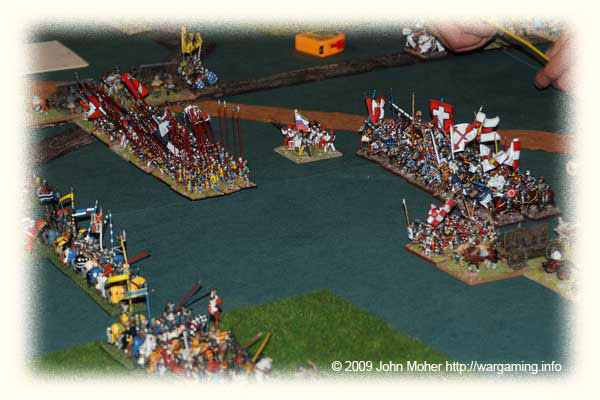
Closing Thoughts: On both the Doubles Tournament & DBMM
The Kushans were a surprisingly effective army – and great value for money (in my opinion) – there is virtually nothing in the army that isn’t effective and/or usable depending on the opposing troop combinations. It also has very little it can’t deal with, as Cam pointed out only Kn(O) and Kn(S) in numbers are a real concern and I think the Portuguese game proved that these can be handled at a pinch, but perhaps large numbers of Bw(S), especially in rough, might be the real challenge? Other Medium Foot in rough in numbers would be annoying (e.g. Superior Auxilia), as you can’t really go in and get them with anything, but likewise they wouldn’t threaten you at all and in the open are reasonably easily dealt with by the Lh(S) and Kn(X) combination.
The self-propelled (i.e. impetuous) Chionites work great, and we rarely had situations where we needed to restrain them (although the couple of times we did it was of course always the critical moment when PiPs were short)! I also think the fighting power was surprisingly good – we mixed it up pretty wildly (in fact I think Cam had a few palpitations at some of the manoeuvres my troops pulled) but almost invariably the troops were robust and versatile enough to fight their way through the opposition, allowing the army to be fairly aggressive where ever we chose to make our main effort. One interesting quirk Campbell observed was that in all 4 games the person commanding only 1 command ended up doing over half the fighting and inflicting generally a disproportionate number of casualties on the enemy – was this a specific ‘doubles’ effect caused by only having 3 commands, perhaps allowing the player with just one command to really concentrate on maximising the actions his command’s elements made each bound? However this structure can also be an issue – using the Chionite Lh(S) variant there are only 3 fighting commands, and no Ally options – so for a Doubles Tournament you are always stuck with an odd number of fighting commands, and as a result a slightly unbalanced army structure…
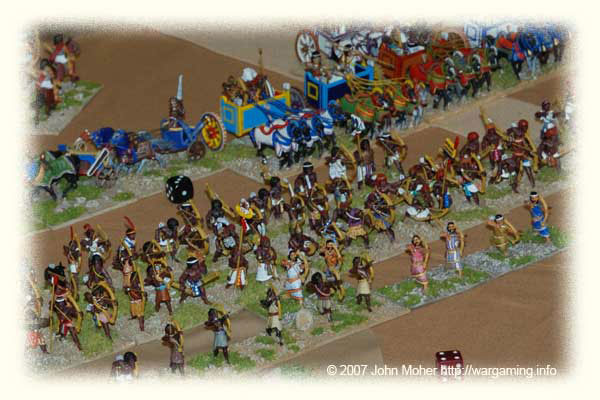
Campbell (and I) were also both surprised at how many “I didn’t know that” moments there were in our games, despite the number of games we had played previously and the fact most of our opposing players were reasonably (or even more) experienced. These instances were often quite important too, having significant influence on the events. For instance:
- We were totally surprised by the delayed Kushite command mugging our Lh(S) on the baseline. This was a rule we didn’t really know well, and if we had actually thought about a delayed command as a possibility we both would have presumed our troops would flee away from the delayed command anyway, exactly as they would with a flank march. You have to really know the specific rules on delayed commands to properly understand the danger of going near the enemy baseline early in the game when a command is off table.
- In the Carthaginian game, Al & Benny were surprised by the fact you can’t switch commands at 10am, while we did not realise that Expendables hit in rear are automatically removed (rather than just fighting at a disadvantage) – so getting around behind Expendables is the best way of fighting them and should be SOP when faced by them. Both these were significant effects on that game for both sides.
There were, surprisingly, lots more of these types of moments.
One thing Campbell found exasperating was the plethora of rear attacks. Engineering rear attacks, particularly using the new slip and slide with an extra 80p, is the new buttocks of death – its the new ‘cheese’ move ‘par excellence‘. Cam and I had both expected DBMM would eliminate the worst of these ‘cheesy’ moves that plagued DBM, but they are just back in a different form, and I know that really annoys Cam (I am a bit more pragmatic – but it definitely annoyed me no end a couple of key times it happened). And Cam feels some of our impetuous moves, and slip and slides, with the Chionites were themselves also very obnoxious and gamey – but that’s regrettably how DBMM currently works. Overall, Cam commented he finds DBMM too complex to really enjoy – that “it felt like hard work most of the weekend” – and I’m inclined to agree. I think that’s why my brain shut down halfway through the third game, and I didn’t finish this tournament feeling quite the same way about DBMM as I did in 2008. I certainly felt totally unenthused about the thought of going to NatCon 2009 at Easter and playing 6 DBMM singles games in 3 days!
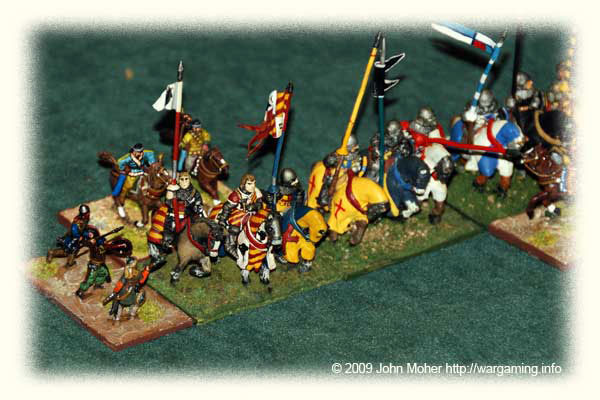
The highlight for Cam was the delayed Kushite command mugging our troops – a real surprising and (in hindsight) funny moment that DBMM can certainly deliver from time to time. But it was only a surprise because we did not understand how delayed commands work. Really the rule as it stands sucks (ignoring how it affected our game, its not sour grapes, just common sense) – its inconsistent (since DBMM is supposedly about accurate portrayal of real life) and has the artificial and unrealistic edge of the world (table) smell.
Cam’s final words were “Good competition, good players, not sure about the rules“.
For me the highlights were the Portuguese Game in general – it was intense, challenging, and decisive, but played in good spirits (and I’ll always believe we should and could have won – bloody dice!), and the Kushite Egyptian game, we almost fought our way to a fantastic victory from a complete disintegration of our army, and even if we had lost fighting to the conclusion would have really been satisfying…
That’s DBMM for me & Cam for a while – Cam has indicated he’s planning on playing FOG for the foreseeable future, and I have promised a couple of our ‘other half of the club’ Ancients players to finally play some FOG games myself – and I played my first ever game the weekend immediately after BattleCry, so for the next few months through the middle of 2009 I’ll be FOG bound, and I may write up my general impressions and experiences here on my site.
But as a closing statement I don’t intend playing two sets of rules ongoing, and to be honest I don’t expect a lot from FOG in the way of ‘character’ rather just a very conventional & formulaic set of rules. So by late 2009 I’ll expect to be decided which (if either) set I’ll be playing from 2010 and on, and which set or sets will be going back on the bookshelf… Perhaps it’ll actually be time to revisit Tactica or Armati or Lost Battles, or perhaps even to just put the Ancients away for a while…
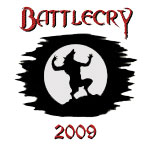
One thought on “BC’09 Conclusion: Results & Aftermath”